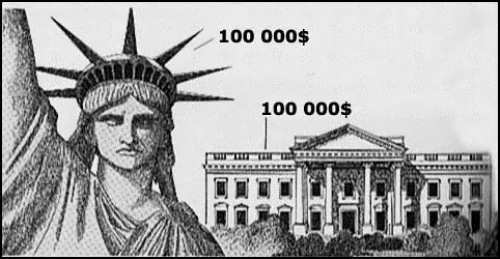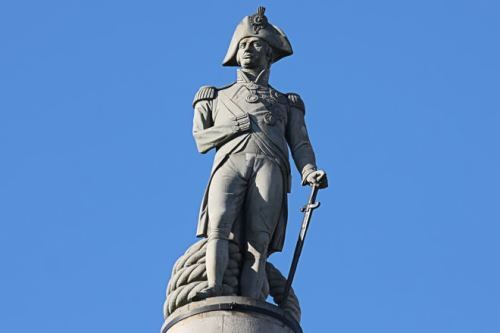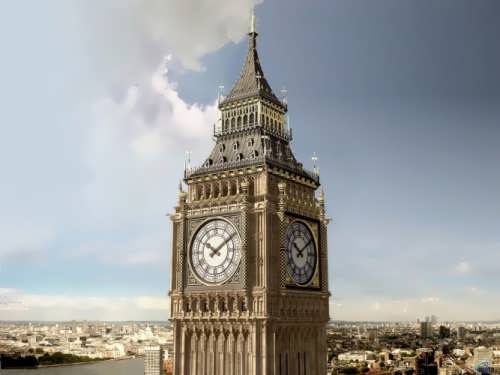Super Salesman by F. A. Campbell
One sunny morning in 1923, Arthur Ferguson was walking across Trafalgar Square in London when he saw a richly dressed young man — obviously an American — standing in front of Nelson’s Column. The American was gazing up in reverent admiration at the monument to England’s greatest admiral.
Just for a laugh, Arthur went up to the young man and introduced himself. Could he be of service? He was, after all, caretaker of this ancient monument. Yes, the statue on the top was indeed that of Lord Nelson, England’s greatest hero. Such a shame that it would have to go. Trafalgar Square would never be the same without it. But the British economy was extremely weak, and the country had to have the money. The column, statue, lions and fountains, all had to be sold.
“Gee,” sympathized the American, “that’s too bad.” “Yes,’ sighed Ferguson, “and all for a mere $6,000.’ The American became even more interested. Of course, Ferguson went on, it would have to be the right buyer. Nelson’s Column could not be sold just to anyone. It would have to be someone of distinction, of impeccable taste — someone who would truly appreciate this great monument to England’s former glory. And already there was a waiting-list of enthusiastic buyers, all distinguished people.
By this stage the American was practically foaming at the mouth with eagerness. Quite by chance, it was Ferguson himself who had been entrusted with the sad task of making the sale. Of course the whole thing had to be kept secret: the people of England would probably go berserk if they found out in advance. Stammering in his excitement, the American begged Ferguson to help him jump the queue. And although the courteous caretaker of the great monument seemed doubtful at first, he eventually agreed to telephone his superiors for instructions.
He returned within minutes. It had been a struggle, but they had finally agreed. Britain was prepared to accept a cheque right away and complete the whole deal without further delay. Ever helpful, Ferguson gave the American the name and address of a reliable firm who would be pleased to arrange the dismantling and shipping of the Column.
The American then handed Ferguson a cheque, Ferguson handed the American a receipt, and the two men parted. Ferguson went at once to the nearest bank and cashed the cheque.
The new owner of Nelson’s Column walked proudly back to his hotel, ate a celebration lunch and, later in the afternoon, rang up the recommended firm. Strangely enough they were reluctant to accept the job, and they explained why. But only when got in touch with Scotland Yard, the red-faced buyer admitted that he had been swindled.
That summer was a happy one for Arthur Ferguson. The police, however, were not quite so pleased. One rich American complained that he had paid $10,000 for Big Ben.
Another reported that he had made a $2,000 down payment on Buckingham Palace. He had been unable to complete the purchase and the seller had disappeared.
In 1925, Ferguson went to Washington. There he leased the White House to a cattle rancher for 99 years at the give-away price of $100,000 a year — the first year’s rent in advance, of course.
Ferguson’s nest egg was now large enough and he began to consider retirement. But vanity did not allow him to slip quietly from the scene without a really grand finale to his career.
This time his victim was an Australian from Sydney. Ferguson’s sales-talk was inspired. New York Harbour was to be widened but, unfortunately, the Statue of Liberty was in the way. Consequently, the Government was prepared to sell the Monument to anyone willing to take it away.
The Australian spent the next few days trying to raise the $100,000 deposit from Sydney. Ferguson never left his side, keeping him well away from anyone to whom he might be tempted to boast of the bargain he had made. But as a souvenir of the deal, Ferguson kindly allowed himself to be photographed arm in arm with his buyer in front of the Statue of Liberty — soon to be Australian property.
There was a delay in getting the money through, and Ferguson grew impatient — and the Australian suspicious. Finally, he took the photograph to the police and told them his story. Yes, they certainly knew about the super-salesman of great monuments, but until then he had always managed to escape them. Not this time.
Ferguson was jailed for five years. He was released in 1930 and moved to Los Angeles, where he lived in luxury until his death in 1938.
Супер продавец (Ф. А. Кэмпбелл)
Одним солнечным утром в 1923 году, Артур Фергюсон шел по Трафальгарской площади в Лондоне, когда он увидел богато одетого молодого человека — очевидно американца — стоящего перед Колонной Нельсона. Американец с восхищением взирал на памятник величайшему адмиралу Англии.
Просто для смеха, Артур подошел к молодому человеку и представился. Мог ли он быть полезен? Он был, в конце концов, смотрителем этого древнего памятника. Да, статуя была посвящена лорду Нельсону, величайшему герою Англии. Будет жаль, если ее не станет. Трафальгарская площадь никогда не будет прежней без нее. Но британская экономика была крайне слаба, а у страны должны быть деньги. Колонну, статую, львов и фонтаны, все придется продать.
«Ну и дела», посочувствовал американец, «это очень плохо».
«Да», вздохнул Фергюсон, «и все всего за 6000 долларов».
Американец еще больше заинтересовался. Конечно, Фергюсон продолжал, это должно быть подходящий покупатель. Колонна Нельсона не может быть продана кому попало. Ее следует продать разбирающемуся человеку с безупречным вкусом – тому, кто бы по-настоящему оценил этот великий памятник былой славы Англии. И уже был составлен список заинтересованных покупателей, и все они были выдающимися людьми.
На этом этапе американец выразил свое рвение буквально с пеной у рта. Совершенно случайно, Фергюсон оказался именно тем человеком, которому было поручена эта печальная задача, продажа достопримечательности. Конечно, все это должно было быть секретом: народ Англии, вероятно, сойдет с ума, если узнает об этом заранее. Заикаясь от возбуждения, американец попросил Фергюсона помочь ему пройти без очереди. И хотя вежливый смотритель памятника, казалось, сомневался, он, в конце концов, согласился позвонить своему начальству для получения инструкций.
Он вернулся через несколько минут. Это было сложно, но они, наконец, согласились. Британия готова принять чек сразу и завершить всю сделку без дальнейших задержек. Фергюсон даже дал американцу название и адрес надежной фирмы, которая была бы рада организовать демонтаж и перевозку колонны.
Затем американец передал Фергюсону чек, Фергюсон вручил американцу расписку в получении, и двое мужчин разошлись. Фергюсон сразу пошел в ближайший банк и обналичил чек.
Новый владелец Колонны Нельсона гордо отправился обратно в отель, съел праздничный обед, и во второй половине дня позвонил в рекомендованную фирму. Как ни странно, они не захотели приняться за работу, и даже объяснили, почему. Но, только связавшись со Скотланд-Ярдом, покупатель, с красным от гнева лицом, признал, что был обманут.
Это лето было счастливым для Артура Фергюсона. Полиция, однако, не была столь рада. Один богатый американец жаловался, что он заплатил $ 10 000 за Биг Бен.
Другой сообщил, что он внес $ 2000 аванса за Букингемский дворец, но не смог завершить покупку, потому что продавец исчез.
В 1925 году Фергюсон отправился в Вашингтон. Там он сдал в аренду Белый дом под ранчо для крупного рогатого скота на 99 лет по цене 100 000 долларов в год — первый год, конечно, был оплачен заранее.
Заначка Фергюсона теперь была достаточно большой, и он начал думать об отставке. Но тщеславие не позволило ему тихо уйти со сцены без действительно грандиозного финала в своей карьере.
На этот раз его жертвой стал австралиец из Сиднея. Речи Фергюсона вдохновляли. Нью-Йорк-Харбор был очень распространен, но, к сожалению, на очереди была Статуя Свободы. Следовательно, правительство готово продать памятник любому, кто захочет его вывезти.
Австралиец провел следующие несколько дней, пытаясь получить $ 100 000 из Сиднея. Фергюсон не отходил от него, держа его подальше от тех, кому счастливый покупатель захочет похвастаться сделкой, которую он заключил. Но в качестве сувенира от сделки, Фергюсон любезно позволил сфотографировать себя в обнимку со своим покупателем перед Статуей Свободы, которая вскоре станет собственностью Австралии.
Но произошла задержка в получении денег, и Фергюсон потерял терпение, а австралиец что-то заподозрил. Наконец, он отнес фотографию в полицию и рассказал им свою историю. Да, они, конечно, знали о супер-продавце великих памятников, но ему всегда удавалось скрыться. Но не в этот раз.
Фергюсона посадили в тюрьму на пять лет. Он был выпущен в 1930 году и переехал в Лос-Анджелесе, где он жил в роскоши до своей смерти в 1938.



